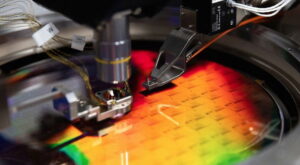PsiQuantum Likely to Launch One Million-Qubit Quantum Computer by 2032
“Where there is a will, there is a way” is one of the motivating factors that drives the global tech industry. Today, a number of tech giants are racing to develop quantum devices that will redefine computing in the near future. From Google to IBM, Microsoft to Xanadu, all these are the top contenders in the quantum computing sprint.
As a result, quantum supremacy isn’t just some phrase that theoretical physicists toss around in classrooms, as those tech companies keep their noses to the grindstone in order to make it a reality. While those big tech players are investing in innovative research to shape the future of computing, many tech analysts don’t seem to be paying attention to the bold vision of PsiQuantum.
Who is PsiQuantum
For starters, it is crucial you grasp the background information of PsiQuantum. The brainchild of Jeremy O’Brien, Terry Rudolph, Pete Shadbolt, and Mark Thompson, PsiQuantum aims to build a generation of computers that guarantees fault tolerance and error correction, thereby meeting users’ commercial computing needs. They have also assembled a world-class team of engineers and scientists to turn this idea into reality.

Little wonder the future-focused company hopes to design, develop and commercialize quantum computers that boost 1,000,000 physical qubits. This is an ambitious goal because even the other top game-changers (mentioned above) are merely working hard to meet their target of 1000 qubits.
PsiQuantum Underlying Technology
Admittedly, 1 million physical qubits in one device will be mind-blowing. However, let’s look at how they intend to achieve this feat. First and foremost, they intend to employ the photon approach because it offers the advantage of error correction.
It is noteworthy that other big industry players like IBM, Google and Microsoft are using this approach to develop their architectures. By maximizing silicon photonics, the California-based company can help users get the most in their various areas of application, such as climate, healthcare, finance, energy, agriculture, communications, etc.
Delving deeper into the underlying technology, the photonic quantum computing approach uses photons as information carriers and then photon detectors and memories to detect and store information respectively. Because the company is using silicon photonics, it becomes pretty easy to integrate single-photon sources and photon detectors.
It would interest you to know that researchers have been able to manipulate individual photons to create a silicon photonic processor. Consequently, silicon photonics can be crammed into many devices with limited space, hence maintaining high precision.
Furthermore, other benefits of silicon photonics are the ability to operate in room temperatures, can hold information for long, are easy to integrate into fiber-optic telecommunication infrastructure and can connect such computers over the Internet. It is even heartwarming that this technology has the so-called time multiplexing architectures, which can scale up millions of qubits. Without mincing words, this is what the Silicon Valley-based company is banking on.
Who Invested in PsiQuantum?
The company’s roadmap indicates that they intend to partner with other companies in order to realize their goal. In fact, in May 2021, they successfully teamed up GlobalFoundaries, a leading semiconductor manufacturer. This collaboration will see the two companies build the silicon photonic and electronic chips that form a part of PsiQuantum‘s plan.
According to Business Wire, as of July 2021, PsiQuantum has already raised $665 million in total funding. It would be recalled that American multinational investment corporation BlackRock led and managed the funding round. Other active participants in the fundraiser were insiders such as Baillie Gifford, M12 (Microsoft’s venture fund), and the new kids on the block like Blackbird Ventures and Temasek. At the end of the Series D round, about 13 companies have taken the plunge to invest in the forward-looking company.
With the funding hurdle surmounted, the PsiQuantum team is all set to deliver “the most profoundly world-changing technology uncovered to date,” said Jeremy O’Brien, the company’s cofounder and CEO. Giving more insights into what the world should expect, CEO O’Brien reaffirmed the team’s resolve to use semiconductors to manufacture millions of qubits that seamlessly perform error correction, which is critical in quantum computing applications.
As for Microsoft’s venture fund M12, the decision to invest in PsiQuantum was due to the company’s technical progress in hardware development alongside its refinement of the next-gen architecture perfectly suited for photonic computing. According to the Managing Director of M12, Samir Kumar, the two companies firmly believe that to develop a commercially useful quantum computer, a need exists for “a good number of logical qubits enabled by fault tolerance and error correction on 1 million-plus physical qubits.”
Time frame for Reaching the Ambitious Goal
This ambitious goal has left a plethora of tech pundits pondering over its viability and how long it would take them to realize it. In truth, no quantum computer of such capacity exists at the moment as the world’s fastest quantum computer is IBM’s Eagle, with just 127 qubits.
Therefore, it makes perfect sense to use IBM’s roadmap as the yardstick for determining the possibility of having 1 million qubits in one digital device. So, if IBM’s too-juicy-to-be-true roadmap is anything to go by, the tech corporation will unveil its digital devices of 100,000 qubits by 2026. Nonetheless, there is no definite timeframe for rolling out quantum computers of 1 million qubits, although the company hopes to achieve that in the future.
From the foregoing, it is crystal clear that nobody should expect a quantum computer of that processing capacity from IBM until 2027 and beyond. Indeed, IBM serves as the yardstick for determining the feasibility of PsiQuantum’s 1 million-qubit computers because the latter has no specific date for actualizing its lofty vision. But is this enough to consider PsiQuantum’s goal wishful thinking? Not at all.
Given their experience, commitment and ability to woo 23 venture capitalists to invest in the project, nobody should write them off. Therefore, all things being equal, PsiQuantum is most likely to launch its first set of quantum computers of 1 million qubits in a decade’s time or beyond. So, look out for it!
